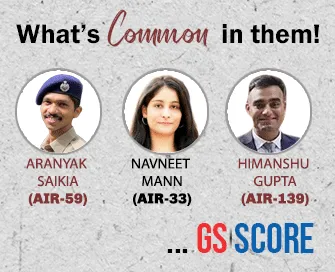


Instruction:
- Attempt both questions
- The test carries 30 marks.
- Write Each answer in 150 words.
- Any page left blank in the answer-book must be crossed out clearly.
- Evaluated Copy will be re-uploaded on the same thread after 2 days of uploading the copy.
- Discussion of the question and one to one answer improvement session of evaluated copies will be conducted through Google Meet with concerned faculty. You will be informed via mail or SMS for the discussion.
Question #1. Short note on Consanguineous mating
Question #2. Write short notes on Cognitive Anthropology.
(Examiner will pay special attention to the candidate's grasp of his/her material, its relevance to the subject chosen, and to his/ her ability to think constructively and to present his/her ideas concisely, logically and effectively).
STEPS & INSTRUCTIONS for uploading the answers
Step 1 - The Question for the day is provided below these instructions. It will be available at 7:00 AM.
Step 2 - Uploading of Answers : Write the answer in A4 Sheet leaving proper margins for comments and feedback and upload the PDF in MY ACCOUNT section. Click on the option of SUBMIT COPY to upload the PDF.
Step 3 - Deadline for Uploading Answers: The students shall upload their answers by 7:00 PM in the evening same day. The first 50 copies will be evaluated.
Step 4 - Feedback : Mentors will give their feedback for the answers uploaded. For more personalised feedback, join our telegram channel by clicking on the link https://t.me/mains_answer_writing_cse . A one-to-one session will be conducted with the faculty after copy evaluation in 72 Hrs.
Model Answer
Question #1. Short note on Consanguineous mating
Hints:
- Inbreeding or consanguineous marriage is found in many communities across the world. Impacts of inbreeding are mainly deleterious.
- This social phenomenon having implications on human health can only be controlled by cultural response.
- Inbreeding means marriage between close relatives who consider themselves having a common ancestor a few generations back.
- The degree of consanguinity depends upon the distance of relationship and it also varies from society to society.
Forms of consanguineous marriages:
- Consanguineous marriage is practiced in different societies at different degrees.
- There are different forms of consanguineous marriages which are classified based on the magnitude of relationships:
– First cousin marriage
– Second cousin marriage
– Uncle-niece marriage
In some societies, consanguineous marriages have been encouraged, for example, in Egyptians and Incas favoured unions of brothers and sisters of the reigning dynasty to maintain ‘royal blood’ in the family.
However, reasons for practicing such marriages are varied from one community to the other. It is called Incest. However, generally incest is considered a taboo across all societies.
Prevalence in India:
- According to NFHS-4 (2015), fourteen percent of marriages in India are consanguineous marriages, which are more common in all of the southern states except Kerala.
- Pondicherry records the highest level of consanguineous marriage (uncle-niece) in a single generation, with 54.9%
Impacts of inbreeding:
Inbreeding has no effect on the inheritance of dominant alleles but has effects on that of recessive alleles in the following ways:
- Effects of inbreeding or consanguineous marriage in the short run:
- Close relatives share several alleles or genes in common. Because of inbreeding the probability of a carrier mating another carrier increases.
- Consequently, there is increasing homozygosity of recessive alleles or recessive genetic disorders get exposed or appear in the population.
Example1:
Although 0.1 % of marriage in the USA is between first cousins. However around 8% of albino children are found among them.
Example-2:
Dwarfism is prevalent among the Amish people in Pennsylvania in the USA. The number of Amish people is small and do practice inbreeding to maintain cultural identity.
There is found a high percentage of some rare allele such as one responsible for ELLIS-VAN CREVALD syndrome, characterized by dwarfism, polydactyly and malformed heart etc. the syndrome is very rare with fewer than 50 cases are found outside the Amish population but among the small Amish population around 45 cases are known.
Example-3:
Recessive autosomal disorders are quite frequent among the communities practicing cousin marriages.
Effect of inbreeding in the long run:
- Inbreeding is not always considered to be harmful.
- It is found that people who have a tradition for hundreds of years of practicing consanguineous marriage or inbreeding, do have the incidence of harmful recessive alleles less or nil.
- Since consanguineous marriage of much longer duration reduce the proportion of homozygosity through natural selection i.e. through the death of individuals, harmful recessive alleles are lost from the population.
- There by normal alleles continue in the population.
- Thus, in the long run the net result of consanguineous marriage is like those populations without such practices.
- Because of elimination of recessive alleles, the population loses genetic diversity in the gene pool.
- Since the environment is ever changing, mutant gene though mainly harmful can be proved to be beneficial under changing environmental circumstances.
E.g. Sickle cell allele can provide resistance against malaria.
Control of impacts of inbreeding:
- Though inbreeding is mainly harmful and helps in the appearance of genetic disease in the population which cannot be cured at the present level of medical advancement.
- Hence, prohibition of inbreeding through incest taboo can reduce the impacts by preventing from the appearance of recessive disorder.
- Thus, impacts of inbreeding are biological in nature which could be controlled by cultural phenomena i.e. incest taboo.
Question #2. Write short notes on Cognitive Anthropology.
Introduction:
Cognitive anthropology is concerned with what people from different groups know and how that implicit knowledge, in the sense of what they think subconsciously, changes the way people perceive and relate to the world around them.
It is the study of human cognition in cultural and cross-cultural contexts. Cognition is investigated both as content, or knowledge and as a process, such as reasoning.
Meaning and emergence of Cognitive Anthropology:
D’Andrade 1995:
- Cognitive anthropology addresses the ways in which people conceive of and think about events and objects in the world. It provides a link between human thought processes and the physical and ideational aspects of culture.
- This subfield of anthropology is rooted in Boasian cultural relativism, influenced by anthropological linguistics, and closely aligned with psychological investigations of cognitive processes.
Erickson and Murphy 2003:
- It arose as a separate area of study in the 1950s, as ethnographers sought to discover “the native’s point of view,” adopting an emic approach to anthropology.
- The new field was initially referred to variously as Ethno-semantics, Ethnoscience, Ethnolinguistics, and New Ethnography.
- In the first decades of practice, cognitive anthropologists focused on folk taxonomies, including concepts of colour, plants, and diseases.
- During the 1960s and 1970s a theoretical adjustment and methodological shift occurred within cognitive anthropology.
McGee & Warms 1996:
- Linguistic analyses continued to provide methods for understanding and accessing the cognitive categories of indigenous people.
- However, the focus was no longer restricted to items and relationships within indigenous categories but stressed analysing categories in terms of mental processes.
- Scholars of this generation assumed that there were mental processes based on the structure of the mind and, hence, common to all humans.
- This approach extended its scope to study not only components of abstract systems of thought but also to examine how mental processes relate to symbols and ideas.
The methodology, theoretical underpinnings, and subjects of cognitive anthropology have been diverse. The field can be divided into three phases:
Phase 1: An early formative period in the 1950s called ethnoscience.
Phase 2: The middle period during the 1960s and 1970s, is commonly identified with the study of folk models.
Phase 3: The most recent period began in the 1980s with the growth of schema theory and the development of consensus theory.
- Cognitive anthropology is closely aligned with psychology, because both explore the nature of cognitive processes.
- It has also adopted theoretical elements and methodological techniques from structuralism and linguistics. Cognitive anthropology is a broad field of inquiry.
- For example, studies have examined how people arrange colours and plants into categories as well as how people conceptualize disease in terms of symptoms, cause, and appropriate treatment.
- Cognitive anthropology emphasizes the rules of behaviour, not behaviour itself.
- It does not claim that it can predict human behaviour but delineates what is socially and culturally expected or appropriate in given situations, circumstances, and contexts.
Conclusion:
Cognitive anthropology not only focuses on discovering how different peoples organize culture but also how they utilize culture. Contemporary cognitive anthropology attempts to access the organizing principles that underlie and motivate human behaviour.
To participate in answer writing program, Register yourself for the test. Copies will be evaluated only for the registered students. Registration will be closed after the scheduled date.
48 Hrs. Answer Writing, Copy Evaluation and Marks Improvement Cycle
- Step 1 (Answer Writing): Questions will be uploaded on the portal on the scheduled date at 7:00 AM. You have to write your answers on an A4 size sheet leaving margins on both sides based on the UPSC pattern. Mention your name on the 1st page and page number on each page. After writing the answer, Click pictures of each page of your answer sheet, merge them all in a single PDF and upload in the comment section of the same question. Answers should be uploaded before 7:00 PM on the same day.
- Step 2 In Next 48 Hrs (Copy Evaluation & Discussion): After evaluation, the first 50 copies will be uploaded on the same comment box and will be sent to you. In the evening 8:00 PM marks improvement sessions for the test with respective faculty in a group will be conducted online. So that students can get a wider perspective of the topics. Here you can discuss your evaluated copies also with the faculty.

